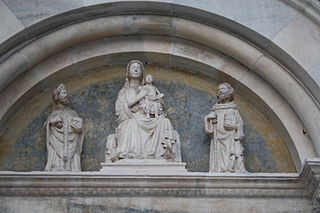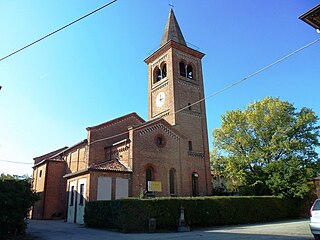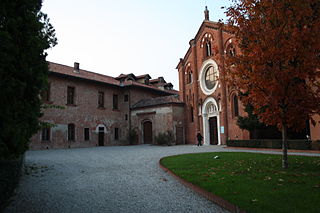
Bobbio is a small town and commune in the province of Piacenza in Emilia-Romagna, northern Italy. It is located in the Trebbia River valley southwest of the town Piacenza. There is also an abbey and a diocese of the same name. Bobbio is the administrative center of the Unione Montana Valli Trebbia e Luretta.

The Order of Canons Regular of Prémontré, also known as the Premonstratensians, the Norbertines and, in Britain and Ireland, as the White Canons, is a religious order of Canons regular of the Catholic Church founded in Prémontré near Laon in 1120 by Norbert of Xanten, who later became Archbishop of Magdeburg. Premonstratensians are designated by O.Praem. following their name.

All Saints' Abbey was a Premonstratensian monastery near Oppenau in the Black Forest in Baden-Württemberg, Germany.

Schussenried Abbey is a former Catholic monastery in Bad Schussenried, Baden-Württemberg, Germany. It is famed for its Baroque library hall. The abbey was established in the 12th century by the Premonstratensian Order and made an Imperial Abbey in the 15th century. The monastery sustained immense damage in the Thirty Years' War. In the 18th century, the abbey began expansions in the Baroque style, but was unable to complete them. The abbey was secularized in 1803 and twice awarded during the process of German Mediatization, eventually becoming a possession of the Kingdom of Württemberg. Its second king, William I, opened a foundry on its grounds, which was followed by a nursing home. These ceased operation or moved out of the monastery in the 1990s.

One of the first streams of Romanesque architecture in Europe from the 10th century and the beginning of 11th century is called First Romanesque or Lombard Romanesque. It took place in the region of Lombardy and spread into Catalonia and into the south of France. Its principal decoration for the exterior, bands of ornamental blind arches are called Lombard bands. It was characterized by thick walls and lack of sculpture in facades, and with interiors profusely painted with frescoes.
Ursberg Abbey is a former Premonstratensian monastery, now a convent of the Franciscan St. Joseph's Congregation, situated in the small village of Ursberg in the district of Günzburg, Bavaria.

Marchtal Abbey is a former Premonstratensian monastery in Obermarchtal in the Alb-Donau-Kreis, Baden-Württemberg, Germany. The minster church of Saints Peter and Paul, the former abbey church, located on a prominent elevation, still dominates the landscape for miles around.
Roggenburg Abbey is a Premonstratensian canonry in Roggenburg near Neu-Ulm, Bavaria, in operation between 1126 and 1802, and again from its re-foundation in 1986. Since 1992 it has been an independent priory of Windberg Abbey in Lower Bavaria. The monastery manages a training centre and a museum, and is widely known for its almost unchanged Baroque building and the organ concerts that are held in the church.

Windberg Abbey is a Premonstratensian monastery in Windberg in Lower Bavaria, Germany.

Rot an der Rot Abbey was a Premonstratensian monastery in Rot an der Rot in Upper Swabia, Baden-Württemberg, Germany. It was the first Premonstratensian monastery in the whole of Swabia. The imposing structure of the former monastery is situated on a hill between the valleys of the rivers Rot and Haslach. The monastery church, dedicated to St Verena, and the convent buildings are an important part of the Upper Swabian Baroque Route. Apart from the actual monastic buildings, a number of other structures have been preserved among which are the gates and the economy building.

Børglum Abbey was an important Premonstratensian abbey of medieval Denmark, located in Børglum parish, in the commune of Hjørring, approximately five kilometers east of Løkken in north central Jutland between the 12th-century until reformation.

Geras Abbey is a Premonstratensian monastery in Geras in Lower Austria. Since 1783 it has also owned the premises of the former Pernegg Abbey nearby.

John of Meda, Ord.Hum., also known as John of Como, was an Italian monk of the Humiliati Order and abbot at their monasteries at Milan and Como. He has been declared a saint by the Roman Catholic Church.

The Abbey of Santa Maria di Rovegnano is a Cistercian monastic complex in the comune of Milan, Lombardy, northern Italy. The borgo that has developed round the abbey was once an independent commune called Chiaravalle Milanese, now included in Milan and referred to as the Chiaravalle district.

Garegnano Charterhouse, also known as Milan Charterhouse is a former Carthusian monastery, or charterhouse, located on the outskirts of Milan, Italy, in the Garegnano district. It now houses a community of Capuchin Friars.

Monluè is a district ("quartiere") of Milan, Italy, part of the Zone 4 administrative division, located east of the city centre. It is a small residential district that originated as a rural settlement. As a consequence of its isolation from the city proper, it has maintained wide green areas and the general appearance of a small country town. The prominent landmark of the district is the eponymous Cascina Monluè, an ancient abbey built by the Humiliati religious order, that has been later adapted as a cascina (farmhouse) and is now used as the venue for a number of concerts and cultural events, especially in summer. Also of interest is the Church of Saint Lawrence, also built by the Humiliati in the 13th century.

Gratosoglio is a district (quartiere) of the city of Milan, Italy, part of the Zone 5 administrative division. It is located at southernmost end of the city, bordering on the comune of Rozzano, and it is traversed by the Lambro river.

The Abbey of Viboldone is an abbey in Viboldone, a frazione of San Giuliano Milanese, in the province of Milan, northern Italy.

Morimondo Abbey is a former Cistercian monastery located at Morimondo, a few kilometers south of Abbiategrasso in the Metropolitan City of Milan, Lombardy, northern Italy. The surviving structure is Romanesque and Gothic. It was founded in 1134 as a daughter house of Morimond Abbey near Dijon, from which it took its name.

Hamborn Abbey is a Premonstratensian monastery in the Alt-Hamborn district of Duisburg, Germany. The abbey is physically located in the diocese of Essen, although not formally part of it.


















